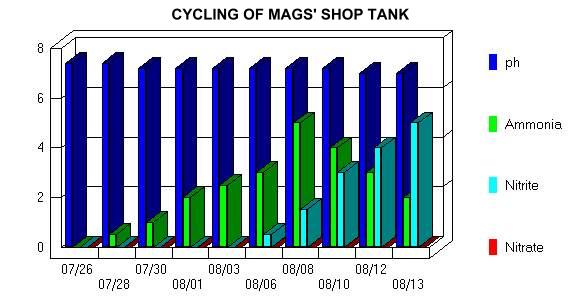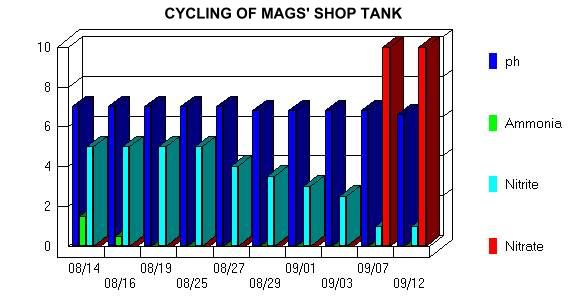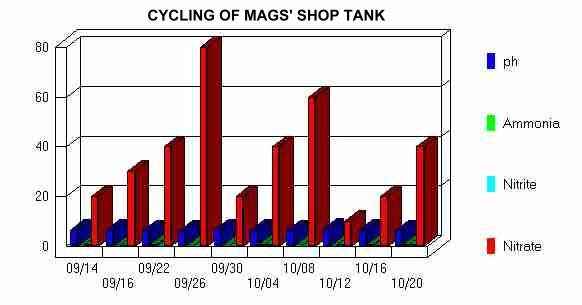


|
Here are the actual cycling numbers of my current home aquarium. They are presented in a graph form so you can see the natural progression of the bacterial growth.

As you can see by the chart the first few days of the new tank are great! Levels are low and the fish are happy. But after just four days ammonia levels rise to a point where it becomes increasingly more difficult for the fish. High amounts of air are needed here for the fish to make it through the ammonia spike. As you get to days 10 and 11 ammonia levels can be seen to drop. This is a sigh of relief at this point for you and the fish. Don't get nervous during this time and put ammonia chemicals in the water. These chemicals do not remove ammonia just turn them into less harmful ammonium. These chemicals will help the fish but prolong the biological filter from taking hold because ammonia is what the bacteria eat. Take away the food source and you take away the bacteria! In the next section on "Starter fish" we will discuss fish to use during this time and have patients the fish if healthy will make it. Remember just feed just a little, aerate a lot, test the water a lot, and change the water every two to three days. The fish should make it and you'll be on your way.

As with the ammonia spike, nitrite levels soar. This stage seemed to go on forever and I thought the levels would never go to zero. Also at first both ammonia and nitrite levels were high and for a while there I would stair at the fish in the tank and watch their every move. I don't know what I expected to see or do if they were dying but I thought as though I had to keep an eye on them in case CPR was needed. Now I would have to get a picture of that! Ammonia levels dropped pretty fast and I remember breathing a sigh of relief and felt OK about getting a few more fishes. Still of the hardy and cheap kind but I had gotten so few at first that the males were picking on just one fish and I wanted to spread out the fighting so as to not start that dreaded Ick stuff again. As nitrite levels dropped nitrate levels will soar quickly and this will be the first you will see algae starting to grow on things. Hope you have some algae eating fish in the tank to take care of it. Water changes will always be apart of the maintenance of the tank to reduce the levels of nitrate in the tank. The smaller the tank the more often you will have to do the water changes. I have noticed with my ten-gallon tanks that after a 50% water change levels will be at 80ppm in 7 days. I do not like for levels to go over this so I change 50% of the water every 7 to 9 days. Also I have noticed that pH levels have dropped slowly since the tank started and from what I have read I think this is do to the low KH factor of the water and nitric acid being produced is dropping the pH of the water. The tank at work has really dropped. Its levels of pH are around 6.0 to 6.8. These levels are not bad but I'm hoping the water doesn't fluctuate too much because of the low KH factor. KH at work is 1 to 2 and KH at home is 2 to 4. KH is the carbonated hardness of the water. It is the measure of carbonate (CO3) and bicarbonate (HCO3) ions in the water. These elements in the water help to stabilize the pH in the aquarium water. Water with a low KH will tend to have a low pH. High KH will tend to have a high and stable pH. As more acid is present in the water the KH of a low KH water will become saturated and pH will fall into the acid range. This is not bad but during water changes if the pH levels are changing rapidly this could cause the fish to become distressed and susceptible to illness. A water purifier will help in this problem and other factor of the water such as GH, which is the general hardness of the water. But we could dedicate the rest of the page to water composition. That might be another page there? Well, as always if you have questions please feel free to E-mail me or the Badman on any of these subjects. We will try to answer them, as best we can and don't feel you need a degree in chemistry to keep fish. I only talk about these subjects to help you understand what is going on in your tank. Also do not try, purchasing, or messing with chemicals to change these levels. Water chemistry is a tricky and difficult thing to mess with. Not to be tampered with by rookies. And I am a firm believer of the fewer chemicals in the water the better off the fish will be! Mags
Here are the actual cycling numbers of my current office aquarium. They are presented in a graph form so you can see the natural progression of the bacterial growth.

As you can see from the chart the ammonia levels at the shop climbed up the same way, as did the home tank did. After about 10 to 12 days the levels started to fall as nitrite levels increased. Now remember that the tanks I used in this were both 10-gallon tanks. I have been getting a lot of E-mail from people who say that their tanks still haven't dropped in ammonia levels after 2 weeks. Remember that larger bodies of water are more forgiving and it takes more time to saturate the water with ammonia. A bacterium that is attracted to your tank for ammonia cannot settle into the tank until ammonia levels are high. This high level of ammonia attracts the bacteria to your tank. Without a food source in ample quantity in the tank the bacteria cannot support a colony in the tank. This is where the tank size comes in. 10 gallons of water will build up ammonia levels quicker than say a 20-gallon tank. Now if you have a 55-gallon tank these levels will take even longer to build up ammonia levels high enough to attract bacteria into the tank to start a colony. Also with say 55 gallons of water at 7ppm this takes a bacteria colony a long time to remove this amount of ammonia. I would be guessing but it would seem to me that if you have a 20 gallon tank you can almost take my readings of 10 to 12 days and multiply that by 2 to get 20 to 24 days to see levels drop. It will take that tank of 20 gallons around a week to 10 days just to start getting ammonia levels high enough to start attracting bacteria. But remember "if you build it they will come." Well, at least that is what I heard on TV one day. Just keep in mind that these levels will drop eventually and it may take longer than what I have here for my ten-gallon tank. Keep the fish population to a minimum and go lightly on the feedings. If you read my section on Starter Fish and these are the types of fish you are using don't hit the panic button when these levels go high and stay there for a while. If a fish does pass away the fish was probably weak in the first place and would have died anyway. Fish on their long journey to the pet store and eventually to your home have been through a lot and some maybe traumatic. This is why you should study the pet store and their fish. See that they are well feed and come often to see these same fish. After they have been at the pet store for a while they should have calmed down and have been feed well. These fish should easily make it through the cycling of the tank.

Now that the ammonia levels have started to drop nitrite levels begin to rise same as with the home tank. This tank’s levels seemed to take forever to drop. I wasn’t at first using a Penguin Bio Wheel on this tank until about 21/2 weeks into the cycling. I did notice a big difference with and without the Bio Wheel. Now I am not telling anyone to run out and buy one nor do I get kick backs but the time difference was well seen and I have to admit the home tank cycled well before the work one did and both were started within a day of each other. The work tank being started before the home tank too. The Bio Wheel I guess gives more surface area in which the bacteria can grow and with the water constantly being run over it, it made a difference. Also this is where I noticed a pH drop. I did test on my water straight out of the tap at home and at work. Work KH level was 1 to 2 dH and home was 2 to 3 dH. The work tank pH level dropped and is still at a low level. Coming out of the tap pH at the shop was 7.8 and home is about the same. I was like many of you playing with dropping the pH down because I read that ammonia at low pH did not effect the fish as much as a high pH level with the same amount of ammonia. Also you read that fish do better in their acidic levels that they are used to. Like I said before do not mess with the pH levels of the water. This is another newbie mistake and one that should be avoided. As you can see my pH levels dropped all by themselves. With a low KH level the buffer in the water gets saturated fast and pH drops easily. Now I have been concerned about levels of pH being to low. I test the water after a water change always. The water that I pull out of the tank I save a small sample of it before I dump it down the drain. This is I feel the best way to test the water. I should have mentioned this before but levels of ammonia at lower levels in the tank are higher than ammonia levels at the surface. By pulling out the water you get a more accurate level of ammonia and nitrite in the tank as an average. Remember though this will be an average. The levels at the bottom of the tank will be higher and levels at the surface will be lower. When the tank cycles it won’t matter and all levels should be zero with the exception of nitrate which the water change will dilute. The problem I feel now with the pH being low is that during water changes the pH will increase do to the higher pH water being put in plus increasing the KH (buffer) level. But more on this in the next part.

On this last chart you can see that levels at this time were almost nothing and nitrate levels climbed. This chart also shows very well the increases and decrease of nitrate levels during and after water changes have been made. As you change the water the nitrate levels are high. As you put in the new water the levels hopefully drop. Those of you who have nitrate levels in your tap water may have a problem here. Some water companies have nitrate levels in the water already and changing the water does nothing to lower the nitrate levels. If this is your case then you may need to get a filter on the tank to remove nitrate or use water bought from a store such as distilled or bottle water. Also while on that subject I will say one thing about distilled water. E-mail has come in about this as well and I will suggest this to all. Distilled water should really never be used in the tank. I as well thought WOW! I will be a great fish keeper and buy only the best for my fish! Nothing but pure water they will love it. Well, that is a great idea but for one problem. Distilled water is a pure water source nothing there but water. This is where the problem is. NOTHING! As you can see from the charts and from what I have been trying to convey. Low KH levels is kind of bad. This KH level in the water gives the water it's stability. Distilled water has NO KH and a pH level of 7 (neutral). This lack of KH makes your water very susceptible to pH fluctuations. It's as I have said the buffer in the water keeps the water stable. At low levels of KH, pH fluctuations occur and pH levels drop. The higher the KH level the more stable the waters pH level is to dropping. During water changes the pH levels will increase again and this may make the fish uneasy. My water levels in the tank go from around 6.0 pH to around 6.8 to 7.0 during the change of water. Now I haven't seen my fish upset or pass away from this change in pH levels but I have read that the levels do bother them. Now I also have some hardy fish and maybe if they were of the more picker type this may have bothered them more. Where the drops in pH come from is the nitrogen cycling of the tank. Nitric acid is produced as well and starts to saturate the KH buffer in the water. At first the buffer absorbs the acid like a sponge. But like a sponge it gets full and the sponge over flows. This over flow is the pH drop in the water. If you are planning on keeping Cichlids this could be a real problem. Most Cichlids like water to be alkaline (above 7.0) and will do extremely poor in acidic water. See more than fish, water and a bubble maker to make those little fishes happy huh! As the same with me I didn't know you had to be a water chemist to keep fish. Just feed them and they will be happy!
Before and after a water change
Before Water Change
After Water Change
|
Next: starter Fish

|
|
|
|
